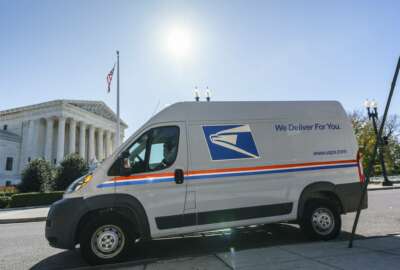The Postal Service went to extraordinary lengths last year to process a record-breaking volume of mail-in ballots and deliver a surge in packages that peaked during the holiday season.
Both the election and the holiday rush are over, but the agency is still struggling to improve its on-time delivery rates for its mail products.
To get a handle on the root cause of these delays, Postmaster General Louis DeJoy told members of the Mailers’ Technical Advisory Committee last week that USPS is creating a dashboard that would give its biggest customers regular status updates on conditions at its facilities and on-time metrics for different types of mail.
Mike Plunkett, the president and CEO of the Association for Postal Commerce, told Federal News Network that the mailing industry has long sought access to this level of agency data.
“Industry has been clamoring for months for some things that would provide visibility into locations where the mail just isn’t moving. People don’t want to compound the problem by trying to enter commercial mail in a facility that is gridlocked,” Plunkett said in an interview.
Faced with USPS slowdowns, this dashboard could help mailers decide whether to send their mail to different facilities or temporarily hold off on sending marketing mail to certain ZIP codes until the situation is resolved.
Demand for this type of data keeps growing with the mailing industry. The National Association of Presort Mailers told the Postal Regulatory Commission in a recent filing that a lack of data on USPS facility conditions has led to significant costs from its members.
“The lack of actionable data on USPS facility conditions during the recent service issues has resulted in NAPM members spending hundreds of thousands of dollars on truck transportation costs to trucks sitting for days trying to unload mail at postal facilities, or sitting for 12 hours only to be told the mail can’t be accepted at a postal facility then have to return the next day and try again,” NAPM wrote.
USPS provided weekly mail performance metrics in 2020 as part of judges’ rulings in a dozen federal lawsuits focused on its handling of election mail, but Justice Department attorneys for USPS have stressed that the agency considers this level of performance data confidential and not subject to public disclosure under normal circumstances.
“This information is commercial in nature and would not be disclosed under good business practices,” DoJ attorneys wrote in a court filing last month.
Several federal judges have issued injunctions that have prevented USPS from moving ahead on cost-cutting measures, including a reduction in late and extra trips between mail processing facilities and post offices. USPS appealed several of these lawsuits, but dropped its appeals before the D.C. Circuit Court of Appeals last month.
Allison Zieve, the director of Public Citizen’s litigation group, and one of the attorneys in a USPS lawsuit led by NAACP Legal Defense Fund, told Federal News Network that because USPS dropped its appeals from the orders granting preliminary injunctions, those injunctions will remain in place throughout the duration of the lawsuits.
“For the NAACP case, that means that USPS cannot make the challenged changes to transportation policy. DeJoy had indicated in August that he would reverse the restrictions on late and extra trips until post-election, but he will not be able to reinstitute them while the injunction remains in place,” Zieve said.
The agency’s legal challenges don’t end there. Several mailers associations have asked the D.C. Court of Appeals to prevent a new rate system from going into effect. The rate system, approved by the PRC, keeps a price cap on market-dominant products like first-class mail, but would base the cap on changes in mail density and retirement costs.
The motion, led by the Alliance of Nonprofit Mailers, warns that these new rates would cost mailers approximately $2.3 billion annually.
While USPS performance has stabilized somewhat in recent weeks, Plunkett said DeJoy told MTAC members that the agency is still digging out from delivering a massive volume of packages during its peak holiday season.
Discussion of packages, Plunkett recalled, took up the majority of DeJoy’s remarks to mailers, but offered little to no detail on mail performance, except to acknowledge that USPS expects to soon increase mail rates beyond the rate of inflation, after gaining approval from its regulatory agency.
“The most striking thing to me was how little discussion there was at all about mail. It was very much dominated by focus on the Postal Service’s packages business,” Plunkett said.
However, he said mailers have expressed concerns with an imminent price increase given the agency’s recent performance metrics.
“There’s going to be — and there already is — a backlash, and it’s not good for the entire system. It’s not good for the Postal Service, it’s not good for the customer,” Plunkett said.
USPS data shows the agency only delivered 64% of first-class mail on-time the week of Dec. 26, and less than 62% the week prior.
USPS meanwhile, has pointed to employee availability shortages as the driving force behind delays.
USPS spokesman David Partenheimer said 39,383 employees have tested positive for COVID-19 during the course of the pandemic, but didn’t have a current estimate of the number of employees out of the work because of COVID-19.
An alert on the USPS website warns customers that “USPS is experiencing unprecedented volume increases and limited employee availability” because of the pandemic.
While Plunkett said the on-time delivery problems have gotten more severe during the pandemic, he said USPS has long struggled with performance goals set under the 2006 Postal Accountability and Enhancement Act, the last major postal reform bill passed by Congress.
“If you don’t enforce standards, there really aren’t standards,” Plunkett said.
Copyright
© 2024 Federal News Network. All rights reserved. This website is not intended for users located within the European Economic Area.

